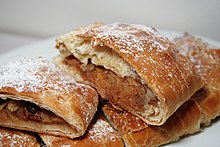Strudel (dish)
A strudel is a pastry made from a filled and baked or cooked rolling pin. It originated in the area of the Habsburg Empire , later found its way into the subsequent national kitchens ( Austrian cuisine ) and is now internationally widespread. The oldest surviving recipe comes from a manuscript titled Koch Puech from 1696, which is in the Vienna Library in the City Hall .
Depending on the recipe, strudel dough, quark dough (Austrian pot dough) or potato dough (Austrian potato dough) are used for the dough .
pastry
Strudel dough is made from wheat flour Type 405 (for pudding swirl produced from potato flour), water and liquefied edible fat or oil. Intensive mechanical processing (fulling and beating) as well as a longer rest period before processing allow the dough to be rolled out or pulled out to the extreme, which ideally becomes so thin that it is translucent when unbaked and yet does not tear.
There are various techniques for manual extraction. So you can roll out thin and then placed over the back of the hand to the dough first style of pizza maker turns off. Then you put the dough on a floured kitchen towel, cover it with the filling and wrap it up with the help of the kitchen towel.
In large-scale production and in the manufacture of ready-made dough sheets, the dough is rolled out very thinly by machine.
Regardless of whether the dough was rolled out or pulled out by hand, the strudel made from it is called pulled ... strudel , for example pulled apple strudel or pulled cherry strudel .
etymology
The origin of the word strudel is seen etymologically with wallen and strudeln - originally, strudel were spiral-shaped pastries (shape of a strudel ). In the 16th century, strudel were made from ten to twelve layers of dough and then sprinkled with powdered sugar after baking. At the end of the 16th century, confectioners began to fill strudels with various fruits or curd cheese. In the 18th century there was a big change in strudel baking: The dough was rolled out very thinly on a table, pulled, filled and then rolled up with a cloth.
Swirl variants
There are innumerable strudel variations, spicy and sour, with or with sweet abundance, such as apple strudel , cream strudel , poppy seed strudel , nut strudel , strudel , cabbage strudel , spinach pie and black pudding strudel . In the Swabian cuisine , there is a meat strudel .
Quark dough (Austrian pot dough)
The occasionally used quark dough consists of equal parts by weight of flour, edible fat and quark. It is characterized by its easy roll-out without sticking. But it cannot be drawn out as thinly as strudel dough.
Potato dough (Austrian potato dough)
This is made from baked or steamed potatoes with the addition of flour, egg, cooking fat and salt. It is used more for strudels with a sour and piquant filling.
Cooked strudel
In Austria known as boiled strudel (from Sieden ), as a rule it is a traditional semolina strudel or a lung strudel, which is cut into slices and mainly used as a soup. The Silesian milk strudel and the Slovenian štruklji are also known .
Trivia
Because of its sinuous shape, the @ sign in e-mail addresses is colloquially referred to in Hebrew as the German word Strudel (hרודל in Hebrew). The official name also refers to the pastry, it is "keruchith" (כרוכית), the Hebrew word for the pastry, strudel.
Web links
- Till Ehrlich : A swirling mixture. Hungarian cuisine beyond the peppers. At: taz.de. February 25, 2006.
- In the vortex of happiness. PDF; 279 kB, accessed on November 7, 2011.




